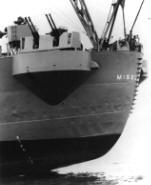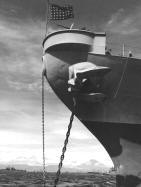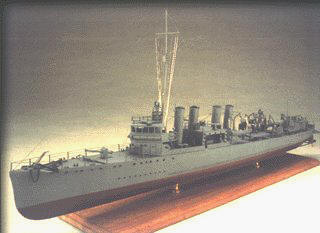By William Cole
Advertiser Military Writer
After looking for 15 years, finding the Japanese submarine that drew the
first fire of the United States in the war in the Pacific was not
something the University of Hawai'i was completely prepared for.
The Hawai'i Undersea Research Laboratory found that out when it
returned to port Wednesday and saw a pier lined with reporters.
When lab acting director John Wiltshire arrived at his office at 7 a.m.
yesterday, he had 100 e-mails and 30 phone messages. The German newspaper
Der Spiegel had called. So had BBC World News. There were a lot of
messages from Japan. Wiltshire figures he talked with 20 to 25 media
outlets.
"I'm still in sort of a state of shock," Wiltshire said late yesterday.
"I didn't realize (the discovery) would generate anything like this. We've
been looking for this on and off for 15 years."
The destroyer USS Ward opened fire and depth-charged the two-man
submarine at 6:45 a.m. Dec. 7, 1941, when it was spotted outside Pearl
Harbor a little more than an hour before the massive aerial attack to
come.
The sub's fate would become a mystery and its sighting part of the
national debate over whether the United States could have been better
prepared for the attack.
"There are two big what-ifs in the Pearl Harbor attacks," said Daniel
Martinez, historian for the National Park Service's USS Arizona Memorial.
"Certainly, the sub incident that morning ... and at 7:02 the radar
contact (with aircraft approaching O'ahu) are those ingredients."
The submarine, with two 18-foot torpedoes still on board, is part of
the "intriguing history" of the Pearl Harbor attacks, Martinez said.
"This midget submarine was involved in the first incident of that
Pacific war and so it's hugely significant," he said. "It launched two
countries into a dramatic and climactic struggle in the Pacific that
lasted over 3 1/2 years." p>Video taken by UH deep-diving submersibles
revealed that the 78-foot submarine came to rest upright in 1,200 feet of
water three to four miles outside Pearl Harbor.
"It's in amazing condition," said Martinez, who also found that depth
charges did not appear to damage the vessel.
Wiltshire called the sub's discovery a "tremendous find for the
University of Hawai'i."
"This puts us on the map as a major player on the world oceanographic
scene," he said. "We were that already, but now we're in the national
news."
Martinez said the underwater video shows that a 5-inch round from the
Ward punched through the base of the sub's conning tower, probably killing
the crew member who would have been positioned there, and leaving a
6-inch-wide entrance hole and, on the other side, an exit hole about 18
inches in diameter.The round is believed to have exploded outside the sub.
Martinez said the hatch remains closed, leading researchers to believe
that the remains of the two crew members are still inside.
The sub, which also had small holes in the hull believed caused by
shrapnel, likely sank from taking on water, Martinez said.
"The dive planes were up, which means that the crew was desperately
trying to keep the vessel from sinking," Martinez said.
Evidence that the Ward found its mark with its 5-inch gun has created a
new controversy: Some media reports portrayed the United States as having
started the war by firing the first shots.
"Nothing could be more further from the truth," said Martinez, who
noted how the portrayal angered some veterans who have begun sending out a
flurry of e-mail.
"What had happened that morning was the Japanese had committed their
military forces to attack the United States here in O'ahu," he said. "It
was a two-pronged attack. One was coming by sea. ... The Japanese had
committed their first overt act of war at 12 o'clock that evening when the
midget submarines were launched."
In fact, when the sub was attacked and sunk by the Ward, the first wave
of Japanese aircraft already had been launched 230 miles north of O'ahu,
Martinez said.
Yoshiaki Yoshima, a historian at Tokyo's Chuo University, said
yesterday that the news of the sinking of the sub offered little in the
way of revisionist thinking. "The fact that the sub was found where it was
proves that Japan was preparing for the surprise attack," he said.
The submarine was one of five launched as part of the Dec. 7 attack
from the backs of larger subs 10 to 12 miles from the harbor. Four of
those submarines have now been accounted for; a fifth, possibly still at
the bottom of Pearl Harbor, remains unaccounted for.
UH deep-diving submersibles located the midget sub in a Navy dumping
ground that includes tracked assault vehicles and 2,000 Navy cups. Over
the weekend, researchers located an unidentified 200-foot gunboat that had
been scuttled.
Martinez, who regards the submarine as a sovereign vessel of Japan,
said the discovery brings up larger issues "having to deal with ownership
of the submarine." Who has jurisdiction over the submarine probably will
be determined within the next couple of days, he said.
Hiroko Taniguchi, the officer in charge of public information and
culture at the Japanese Consulate General in Honolulu, met yesterday with
National Park Service and UH undersea lab officials as part of a
fact-finding investigation.
Taniguchi, who said the consulate learned only yesterday of the
submarine's discovery, had no comment on whether crew remains are still
aboard — a "hypothetical" matter, she called it.
"We started the fact-finding process," she said. "I met a couple of
people already, but I'm still in the process (of determining what was
found)."
Wiltshire said the submarine could be raised.
"It would be a difficult and expensive task," he said while citing the
precedent for raising submarines such as Russia's Kursk. In waters off
Hawai'i, too, the Navy lifted the wreckage of the Japanese fishing vessel
Ehime Maru.
Wiltshire said UH, the National Park Service, the State Department, the
Navy and the National Oceanic and Atmospheric Administration will be
involved in discussions as to the submarine's future.
The Discovery Channel already has been brought on board for the next
submersible trip to the site in December.
With the midget submarine found, it's clear that all the years of
searching has paid off for UH.
"This is probably the most significant marine archaeology discovery in
the Pacific," Wiltshire said.
Advertiser wire services contributed to this report.
Reach William Cole at
wcole@honoluluadvertiser.com or 525-5459.
|




